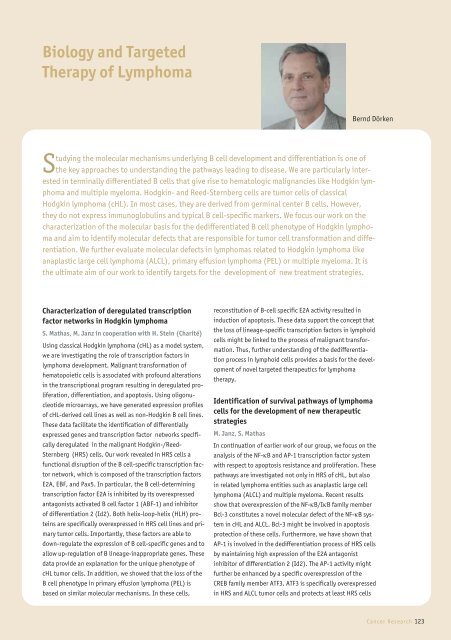of the Max - MDC
of the Max - MDC
of the Max - MDC
You also want an ePaper? Increase the reach of your titles
YUMPU automatically turns print PDFs into web optimized ePapers that Google loves.
Biology and Targeted<br />
Therapy <strong>of</strong> Lymphoma<br />
Bernd Dörken<br />
Studying <strong>the</strong> molecular mechanisms underlying B cell development and differentiation is one <strong>of</strong><br />
<strong>the</strong> key approaches to understanding <strong>the</strong> pathways leading to disease. We are particularly interested<br />
in terminally differentiated B cells that give rise to hematologic malignancies like Hodgkin lymphoma<br />
and multiple myeloma. Hodgkin- and Reed-Sternberg cells are tumor cells <strong>of</strong> classical<br />
Hodgkin lymphoma (cHL). In most cases, <strong>the</strong>y are derived from germinal center B cells. However,<br />
<strong>the</strong>y do not express immunoglobulins and typical B cell-specific markers. We focus our work on <strong>the</strong><br />
characterization <strong>of</strong> <strong>the</strong> molecular basis for <strong>the</strong> dedifferentiated B cell phenotype <strong>of</strong> Hodgkin lymphoma<br />
and aim to identify molecular defects that are responsible for tumor cell transformation and differentiation.<br />
We fur<strong>the</strong>r evaluate molecular defects in lymphomas related to Hodgkin lymphoma like<br />
anaplastic large cell lymphoma (ALCL), primary effusion lymphoma (PEL) or multiple myeloma. It is<br />
<strong>the</strong> ultimate aim <strong>of</strong> our work to identify targets for <strong>the</strong> development <strong>of</strong> new treatment strategies.<br />
Characterization <strong>of</strong> deregulated transcription<br />
factor networks in Hodgkin lymphoma<br />
S. Mathas, M. Janz in cooperation with H. Stein (Charité)<br />
Using classical Hodgkin lymphoma (cHL) as a model system,<br />
we are investigating <strong>the</strong> role <strong>of</strong> transcription factors in<br />
lymphoma development. Malignant transformation <strong>of</strong><br />
hematopoietic cells is associated with pr<strong>of</strong>ound alterations<br />
in <strong>the</strong> transcriptional program resulting in deregulated proliferation,<br />
differentiation, and apoptosis. Using oligonucleotide<br />
microarrays, we have generated expression pr<strong>of</strong>iles<br />
<strong>of</strong> cHL-derived cell lines as well as non-Hodgkin B cell lines.<br />
These data facilitate <strong>the</strong> identification <strong>of</strong> differentially<br />
expressed genes and transcription factor networks specifically<br />
deregulated in <strong>the</strong> malignant Hodgkin-/Reed-<br />
Sternberg (HRS) cells. Our work revealed in HRS cells a<br />
functional disruption <strong>of</strong> <strong>the</strong> B cell-specific transcription factor<br />
network, which is composed <strong>of</strong> <strong>the</strong> transcription factors<br />
E2A, EBF, and Pax5. In particular, <strong>the</strong> B cell-determining<br />
transcription factor E2A is inhibited by its overexpressed<br />
antagonists activated B cell factor 1 (ABF-1) and inhibitor<br />
<strong>of</strong> differentiation 2 (Id2). Both helix-loop-helix (HLH) proteins<br />
are specifically overexpressed in HRS cell lines and primary<br />
tumor cells. Importantly, <strong>the</strong>se factors are able to<br />
down-regulate <strong>the</strong> expression <strong>of</strong> B cell-specific genes and to<br />
allow up-regulation <strong>of</strong> B lineage-inappropriate genes. These<br />
data provide an explanation for <strong>the</strong> unique phenotype <strong>of</strong><br />
cHL tumor cells. In addition, we showed that <strong>the</strong> loss <strong>of</strong> <strong>the</strong><br />
B cell phenotype in primary effusion lymphoma (PEL) is<br />
based on similar molecular mechanisms. In <strong>the</strong>se cells,<br />
reconstitution <strong>of</strong> B-cell specific E2A activity resulted in<br />
induction <strong>of</strong> apoptosis. These data support <strong>the</strong> concept that<br />
<strong>the</strong> loss <strong>of</strong> lineage-specific transcription factors in lymphoid<br />
cells might be linked to <strong>the</strong> process <strong>of</strong> malignant transformation.<br />
Thus, fur<strong>the</strong>r understanding <strong>of</strong> <strong>the</strong> dedifferentiation<br />
process in lymphoid cells provides a basis for <strong>the</strong> development<br />
<strong>of</strong> novel targeted <strong>the</strong>rapeutics for lymphoma<br />
<strong>the</strong>rapy.<br />
Identification <strong>of</strong> survival pathways <strong>of</strong> lymphoma<br />
cells for <strong>the</strong> development <strong>of</strong> new <strong>the</strong>rapeutic<br />
strategies<br />
M. Janz, S. Mathas<br />
In continuation <strong>of</strong> earlier work <strong>of</strong> our group, we focus on <strong>the</strong><br />
analysis <strong>of</strong> <strong>the</strong> NF-κB and AP-1 transcription factor system<br />
with respect to apoptosis resistance and proliferation. These<br />
pathways are investigated not only in HRS <strong>of</strong> cHL, but also<br />
in related lymphoma entities such as anaplastic large cell<br />
lymphoma (ALCL) and multiple myeloma. Recent results<br />
show that overexpression <strong>of</strong> <strong>the</strong> NF-κB/IκB family member<br />
Bcl-3 constitutes a novel molecular defect <strong>of</strong> <strong>the</strong> NF-κB system<br />
in cHL and ALCL. Bcl-3 might be involved in apoptosis<br />
protection <strong>of</strong> <strong>the</strong>se cells. Fur<strong>the</strong>rmore, we have shown that<br />
AP-1 is involved in <strong>the</strong> dedifferentiation process <strong>of</strong> HRS cells<br />
by maintaining high expression <strong>of</strong> <strong>the</strong> E2A antagonist<br />
inhibitor <strong>of</strong> differentiation 2 (Id2). The AP-1 activity might<br />
fur<strong>the</strong>r be enhanced by a specific overexpression <strong>of</strong> <strong>the</strong><br />
CREB family member ATF3. ATF3 is specifically overexpressed<br />
in HRS and ALCL tumor cells and protects at least HRS cells<br />
Cancer Research 123
















